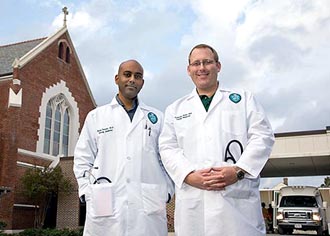Helping Fill the Medical Care Gap
Tulane physicians are partnering with the Daughters of Charity Services of New Orleans to provide medical care to low-income residents at one of the organization's community clinics, the Daughters of Charity Health Centerâ“St. Cecilia, on Rampart Street in New Orleans' Bywater neighborhood.

Dr. Coleman Pratt, right, and Dr. Sarat Raman, both assistant professors in the Department of Family and Community Medicine, are partnering with the Daughters of Charity to provide health care in New Orleans' Bywater neighborhood. (Photo by George Long)
The work of the Daughters of Charity in New Orleans dates from 1834, when they established the original Hotel Dieu Hospital. The organization is dedicated to helping the poor and to providing clinical training opportunities to medical students to ensure the development of new generations of doctors.
“We are seeing primarily working but uninsured patients,” says Dr. Coleman Pratt, assistant professor in the Department of Family and Community Medicine at the Tulane School of Medicine. “Our clinic is in Bywater, so our patients are about 50 percent working-class black folks, and then we have some interesting patients some more transient young people in the 'bartender and artist' class. We also provide some transgender services here.”
Pratt is medical director of community health services at the St. Cecilia clinic. He sees patients at the clinic as well as overseeing the operations of three mobile clinics run by the Daughters of Charity. One of these units is dedicated to prenatal care, another to baby health care, and the third provides primary care focusing specifically on the healthcare needs of the homeless.
“The mobile units go to Central City, to Kenner; we work with the St. Joseph Rebuild Center on Tulane Ave. We go all around the city,” says Pratt.
The St. Cecilia clinic is one of the rotation sites for medical students in the Department of Family Medicine. There are actually two rotations, according to Pratt. One is the basic family medicine clerkship, which is a patient-care experience with a small amount of exposure to the administrative side of running a clinic. The other is a fourth-year elective rotation focused specifically on the care of indigent patients.
“The students in this rotation will not just do direct patient care,” says Pratt, “They will also get significant exposure to the administrative side of running a clinic how to fund the work we do, how to write grants, what a federally qualified health center is, what a community health center is what does it all mean? The third part of it is exposure to advocacy, learning to use their position as a doctor to advocate for their patients in the community.”
Dr. Sarat Raman, assistant professor of family medicine, serves as associate medical director for population health at St. Cecilia. He is working on a project funded by a grant from the United Health Foundation to track and monitor the major chronic diseases of the clinic's patient population based on a preventive model.
“In the traditional model of medicine, you get sick and you go to see the doctor,” says Raman. “The United Health Foundation grant is allowing us to change the way in which we see and evaluate patients. It's more of a population-based as opposed to an individually based management style. We know our patients have chronic states such as diabetes, heart disease, asthma and depression, so we actively try to prevent them from getting too far advanced or waiting until they have complications before we treat them. It's a preventive approach.”
